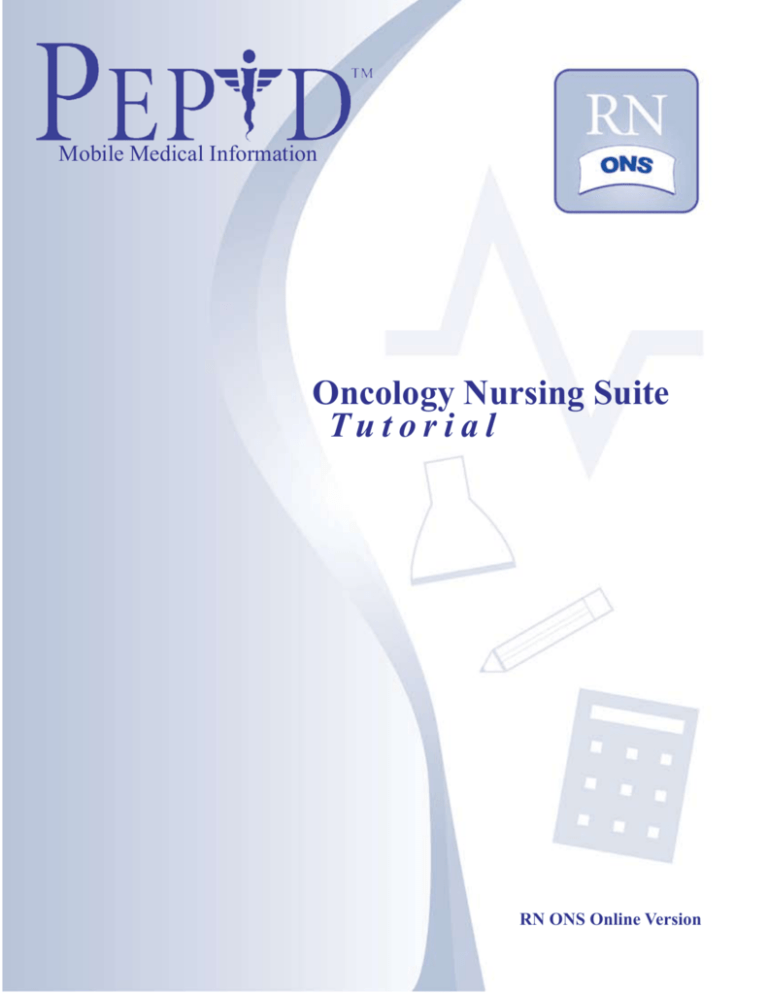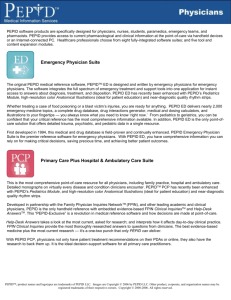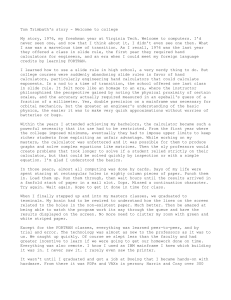
Mobile Medical Information
Oncology Nursing Suite
Tutorial
RN ONS Online Version
Home Index.........................................1-2
Back........................................................2
Top..........................................................2
Table of Contents....................................3
Lab Manual.............................................3
Medical Calculators................................4
Quick Reference.....................................5
Drug Interactions Generator................5-6
Acute Care Hotlink.................................7
Note........................................................8
Quicklinks Menu....................................9
Camera...................................................9
IV Drip Rate...........................................9
{Rel. Topic} Related Topics........................................9
[Tx] Treatment................................................9
[Nx] Nursing Considerations..........................9
Test...................................................11-14
Answers................................................15
PDA and online information resources and clinical tools are essential for every professional working in
today’s mobile healthcare industry. No modern medical and nursing curriculum is complete without an
authoritative handheld reference and training on how to use it.
This tutorial will teach you how to utilize every aspect of PEPID. From the Medical Calculators and
Drug Interactions Generator, the tutorial has you covered. Included in each tutorial is a quiz, which will
prepare you to quickly and efficiently navigate through PEPID. They are an excellent resource for
integrating PEPID into an educational or clinical setting, and are a strong overview of the product.
Thank you for your interest in the PEPID tutorials.
The Home Index allows you to go to the PEPID Tutorial, Table of Contents, What’s New in
PEPID, System Index, or to do a Topic Search. One advantage with PEPID Online is that there is more
information viewed at one time. The
Home Index is always present in the left column. Once a
topic is selected in the Home Index, it is displayed in the middle column. Any related subtopics will
appear in the
Quicklinks Menu in the right hand column.
To Use:
1. In
Home Index column to the left, type in the letters of the topic you want to search, like
Vtach, for example. Vtach uses every feature of PEPID.
2. Click Vtach in the listing menu. The Ventricular Tachycardia (Vtach) page will appear in the center
column.
3. The
Quicklinks Menu will appear in the right hand column. You will be able to view related
topics, including Diagnosis and Pathophysiology.
4. From the Vtach page in the center, you can click on the
Polymorphic rates, which will appear in the
Camera to view Monomorphic and
right column.
1
5. On the Vtach page, use the right scroll bar to scroll down. Click vagal maneuvers to view more
details. You will see these glossary links throughout the application. Click the
Back icon to
return.
6. Continue to scroll down the Vtach page, and you will come across relevant calculators. You can click
on the Qt int to view the QT Interval Correction equation, or you can click the
Calculator next to the Qt int link to actually use the calculator. Click the
Medical
Back icon to return.
7. Continue to scroll down the Vtach page, and click on the Amiodarone link. From the
Quicklinks Menu, you can view Dosing, Kinetics, IV Info, and Overdose Management to name a few.
If you use the scroll bar on the right hand side, you can view all topics. Scroll down and click on any
of the
IV Drip Rate Icons to use the calculator.
Notes:
• The fastest way to find any topic
• Links directly to the index
• Use keypad to enter the first few letters
• Click entry to select from alphabetical keywords list
• Use scrollbar to navigate complete list
• Alphabetical index is colorized for distinction between keywords
• Drug topics are blue
• Tables of contents are bolded
• Chapter headings are bolded and capitalized
The Back icon takes you to the previous screen. The Back icon can always be found in the
naviagation bar. If you tap on a link to view a subtopic, you can use the Back icon to return to the same
place on the previous screen.
The Top icon allows you to snap to the top of the page. If you need to get to another heading or subject
at the top of the page, this button will help you do so quickly.
2
The Table of Contents (TOC) icon allows you to see all that is offered on your PEPID Oncology
Nursing Suite. The {TOC} link is found throughout the application.
With the
Table of Contents you select from a thematic listing of topics as shown below:
• What’s New
• PEPID/ONS Oncology
• General Nursing
• System & Specialty Nursing
• Clinical Anatomy
• Drug Database
• Interactions Generator
• Medical Calculators
• Lab Manual
• How to Use PEPID Online
• Warning
RN ONS contains an Oncology Tools & Scales section which is equipped with a toxicity grading scale,
BSA and AUC calculators, staging tables amongst other valuable resources. The unique Hematology/
Oncology Labs section contains a wide array of monographs on blood typing, anemia work-ups, platelet
markers and many other topics.
The Lab Manual icon provides critical values and normal ranges for common lab tests listed
alphabetically. The {Lab Test TOC} link takes you to a thematic arrangement of Lab Manuals.
• Optional add-on to PEPID suite subscriptions
• Provides critical values and normal ranges for common lab tests
• Lists conditions and meds associated with atypical levels of measured factors
3
The Medical Calculators icon allows you to view the alphabetically organized medical calculator index
and links you to the medical calculator table of contents. The {Medical Calculator TOC} link located
top right, links you to a thematic arrangement of calculators.
To Use:
1. Click the
Medical Calculator icon in the navigation bar.
2. In the center column, click on the first letter of the desired calculator.
3. Click on the
Medical Calculator to use. The calculator will appear in the right column. See
image below.
4. Input data using your keyboard in spaces provided.
5. Click the Results button to view the answer.
Example:
Calculate the Body Mass Index of a 5’7” female weighing 150 lbs. Result: 23.525 kg/sq.m.
It also tells you that the normal range is 23-27 kg/sq.m.
4
The Quick Reference icon is the best way to view abbreviations list, glossary, procedures, illustrations, etc.
With the
Quick Reference you can view a thematic listing of the following topics:
1. How To Use PEPID
6. Normal Lab Values
2. What’s New in PEPID
7. Procedures
3. Table of Contents
8. Illustrations
4. Abbreviations
9. Why PEPID
5. Glossary/Eponyms
10. Authors
The Drug Interactions Generator icon allows you to select up to 50 different drugs and cross reference
their interactions. The Drug Interactions Generator will appear in the right column.
5
To Use:
1. Click on the
Drug Interaction Generator in the navigation bar.
2. In the right column, click the Select Drugs button.
3. Use your keyboard to enter first three letters of drug.
4. Click individual selections up to 50 drugs.
5. Click the Done button after all selections are made. If you need to remove any of the selections, click
the box in front of the drug.
6. Click the Interactions button.
The Drug Interactions Generator checks interactions between each subject drug and all of the other
drugs you have selected. Non-subject drugs are not compared against each other.
Notes:
• Numbers represent severity of interaction: 1 = low, 5 = high
• Interactions listed by decreasing severity
• When there are multiple interactions between two drugs, the strongest in severeity will be in bold
• Other interactions of same group listed in regular type
• ↑ Indicates drug level or effect of the following drug will be increased
• ↓ Indicates drug level or effect of the following drug will be decreased
• ↑ ↓ Indicates drug level or effect of the following drug will be either increased or decreased
• ATC: anticoagulation
• Click any underlined text for more information
Example:
Cross reference the following drugs: Amiodarone, Biaxin, Coumadin, and Ginger. PEPID found seven
drug interactions. Click on interaction to view details. Three results are as followed:
• 5- ↑ Qt:Amiodarone, Biaxin-Both increase QTc interval, never use combination
• 3- ↑ Amiodarone, Coumadin-Amiodarone increases levels and effects of Coumadin. Possible serious
or life-threatening interaction
• 3- ↑ Coumadin, Ginger-Both are anticoagulants-Potential danger
6
The Acute Care Hotlink (Critical Care Reference) icon provides links to immediate lifesaving protocols:
BLS, ACLS, ATLS, PALS, RSI, procedures, algorithms, quick drugs and drips, etc. The {TOC} Table of
Contents Link located top right, links you to a broader range of topics.
With the
Acute Care Hotlink you select topics from a thematic listing as shown below:
1. Life Support
2. Airway Support
3. Acute Care Procedures
4. Medical Status
5. Shock Types
6. Other
7. Authors
7
The Notes icon allows you to create, edit, and delete notes. Once a note is created, anytime a subject is
searched for that has a note, there will be an alert in the Quicklinks menu in the right column.
To Use:
1. From the
2. Click the
Acute Care Reference, under Shock Types, select Cardiogenic Shock.
Note icon to add a note.
3. In the right column, click on Add New Note.
4. Enter a title in the space provided.
5. Type in the note in the space provided.
6. Click the Save Note button.
The next time you search for the Cardiogenic Shock topic, there will be a line in the right column that
reads “You have personal notes for this page. Click here to view them.”
8
Quicklinks Menu brings up any subtopics in the right hand column. If you click on any of the subtopics in
the Quicklinks Menu, it will bring you to that subject in the middle column. The Quicklinks Menu will
appear only when subtopics are available.
The
Quicklinks Menu allows you to:
• Access subtopic navigation menu when applicable
• Display Quicklink menu in the right column
• Select from list to link directly to subtopic
Other Links
The Camera Icon takes you to all related
Images, including original high-resolution color Illustrations and Rhythm Strips, found
only in PEPID. Images are selected on the
basis of their immediate and direct clinical relevance. For professionals, our enhanced
rhythm strips are near-diagnostic quality; and the illustrations are useful for a variety
of clinical situations including patient
education. Students find these resources handy in study and classroom, as
well as clinical settings.
The IV Drip Rate icon takes you to all available related IV Drip Rate Calculators.
{Rel. Topic} The Related Topic link takes you to broader topics related to current page.
[Tx] The Treatment link allows you to view related treatments.
[Nx] The Nursing Considerations link allows you to view any relevant nursing considerations.
Available only in PEPID RN, RNONS, RNCC, and RNSCC.
9
Test for RN ONS Suite
1) Out of the drugs listed, which combination should be used with caution because of its serious,
possibly life threatening interactions?
a)
rivastigmine and ambenonium
b)
rivastigmine and tacrine
c)
rivastigmine and galantamine
d)
rivastigmine and celecoxib
e)
None of the Above
2) Which is not a differential diagnosis for hyperthermia?
a)
Heat stroke
b)
Endocrine disease
c)
Drugs (malignant hyperthermia)
d)
Transfusion reaction
e)
None of the Above
3) You are injecting clofarabine with a concentration of 1 mg/mL. Your patient has a body surface area of
1.2971 sq.m. The IV infusion should be over how many hours?
a)
3 hrs
b)
2 hrs
c)
1 hrs
d)
4 hrs
e)
None of the Above
4) Out of the drugs listed, which combination should be used with caution
because of its serious, possibly life threatening interactions?
a)
carboplatin and busulfan
b)
carboplatin and amikacin
c)
carboplatin and palifermin
d)
carboplatin and cisplatin
e)
None of the Above
11
5) Which is not a possible complication of accessing an
implanted venous access device (IVAD)?
a)
Infection
b)
Extravasation
c)
Thrombosis
d)
Purpura
e)
None of the Above
6) You have 0.1 U of vasopressin in 1 ml. You are set to give an IV infusion of 0.0005 U/kg/hr to a 140
lbs patient. What should the drip rate be set at?
a)
0.2345
b)
0.4175
c)
0.3175
d)
0.2393
e)
None of the Above
7) In making nursing considerations for assisting with a colonoscopy, which is not a change that must be
monitored by the nurse?
a)
Texture of skin
b)
Oxygen saturation
c)
Vital signs
d)
Vagal response
e)
None of the Above
8) Which is a sign or symptom of melanoma?
12
a)
Change in size, shape or color of mole
b)
Oozing or bleeding from mole
c)
Itchy, hard, swollen, tender or lumpy mole
d)
All of the Above
e)
None of the Above
9) What is the most common adverse drug reaction to imatinib?
a)
Edema
b)
Nausea
c)
Muscle cramps
d)
Rash
e)
None of the Above
10) Out of the drugs listed, which combination should be used with caution because of its serious, possibly
life threatening interactions?
a)
carbenicillin and minocycline
b)
carbenicillin and BCG vaccine
c)
carbenicillin and aspirin
d)
carbenicillin and cefaclor
e)
None of the Above
11) The abbreviation “fb” stands for?
a)
Foreign body
b)
Followed by
c)
Fiber
d)
Fingerbreadth
e)
None of the Above
12) How many classes of NYHA heart failure staging are there?
a)
1
b)
2
c)
3
d)
4
e)
None of the Above
13
13) What is the basal metabolic rate for a 23 year old?
a)
23.3 kcal/sq.m/h
b)
34.3 kcal/sq.m/h
c)
36.7 kcal/sq.m/h
d)
20 kcal/sq.m/h
e)
None of the Above
14) For a patient in Addisonian Crisis, nursing considerations would include?
a)
Frequent assessment of vital signs
b)
Ensure patient airway, oxygenation
c)
Careful I/O
d)
Provide for patient safety
e)
None of the Above
15) What is the minute ventilation for a patient with a tidal volume of 1.3 L and a respiratory rate of
5 resp/min?
14
a)
7 L/min
b)
5 L/min
c)
4.2 L/min
d)
6.5 L/min
e)
None of the Above
Answers
Answer Key:
1)
a
2)
d
3)
b
4)
c
5)
d
6)
c
7)
a
8)
d
9)
a
10)
b
11)
d
12)
d
13)
c
14)
b
15)
d
Topics Covered (per question):
1)
3 Drug Interactions
2)
2 RN ONS Specific
3)
2 Procedures
4)
2 Medical Calculators
5)
2 Drug Monographs
6)
1 Abbreviation
7)
1 Glossary
8)
1 Drip Calculator
9)
1 Dosing Calculator
15
Visit us on the web at www.pepid.com
Questions about downloading, updates or functions?
Phone: 1-888-321-STAT (7828) x206
Web: www.pepid.com/support
E-mail: support@pepid.com
Mail: PEPID LLC, 1840 Oak Avenue, Suite 100, Evanston, IL 60201
Medical or drug content questions? Topic ideas? Want to become an author?
E-mail editorial department: medical_editors@pepid.com
PEPID™, product names, and logotypes are trademarks of PEPID LLC. All images are copyright © PEPID LLC
2006. Other product, corporate, and organization names are or may be registered trademarks of their respective owners.
Copyright © 2000-2006. All rights reserved.





